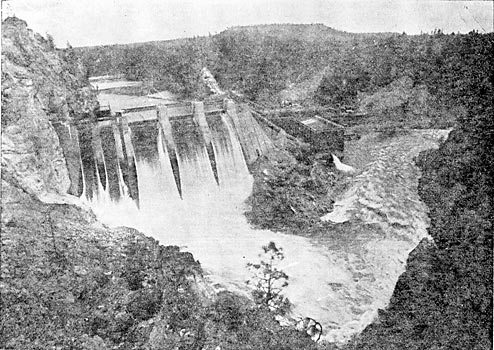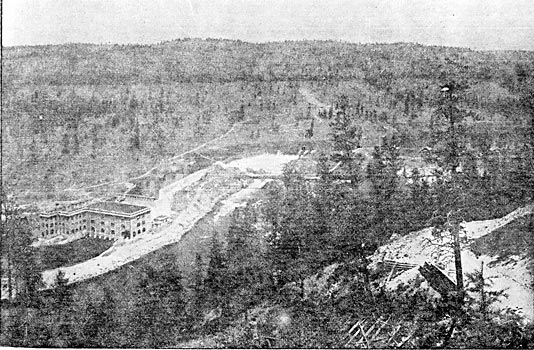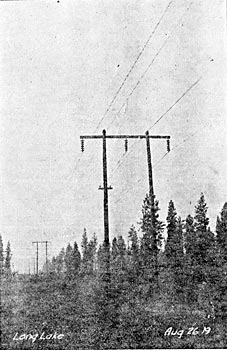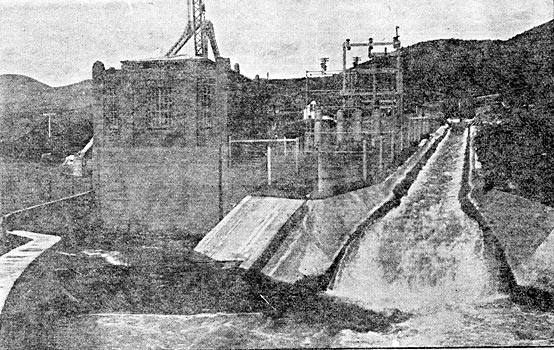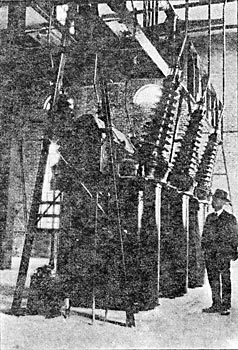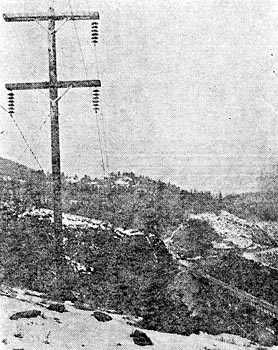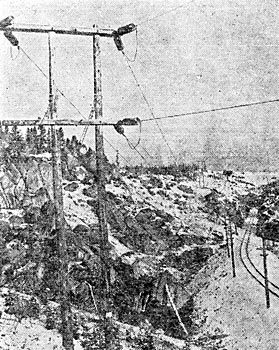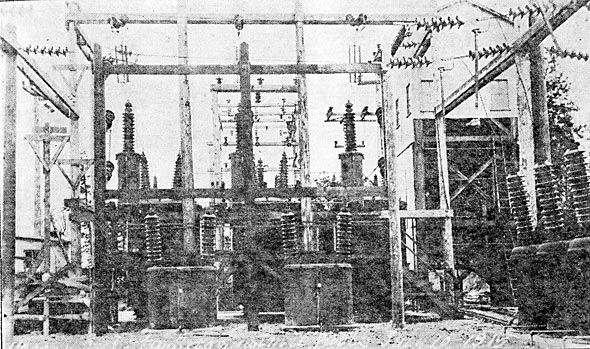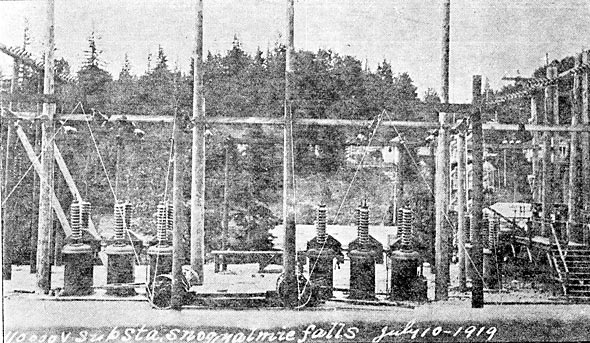[Trade Journal]
Publication: Stone & Webster Public Service Journal
Boston, MA, United States
vol. 25, p. 350-357, col. 1
THE SEATTLE-SPOKANE TRANSMISSION LINE
BY G. E. QUINAN
At five minutes past four, on the twentieth of August, the closing of a switch at Snoqualmie Falls wrought another of those miracles, which in this day of marvels we scarcely pause to wonder about. At that instant the wheels of industry of three states were drawn into perfect rhythm, as the waters of the Walla Walla, Spokane and the Naches united their effort with the rivers of Puget Sound. To use the vernacular, Snoqualmie had synchronized with Long Lake, and approximately 1,500 miles of transmission lines had been interconnected, extending from the eastern borders of Idaho to Olympia, and from Pendleton, Oregon, to Everett.
The closing of this switch was merely the final incident marking the completion of work which has been in progress for over two years, for supplying electric power to the trains of the Chicago, Milwaukee and. St. Paul Railway, between Othello in Eastern Washington, and Seattle and Tacoma, about two hundred miles of road.
| |||
| Long Lake Plant of the Washington Water Power Co., 65,000 Horse Power Capacity |
| |||
| Little Falls Plant of the Washington Water Power Company, 27,000 H.P. Capacity |
In supplying this power 28,000 horse power of water-driven generators will be used, about equally divided between the Long Lake plant, of the Washington Water Power Company, near Spokane, and the Snoqualmie plant of the Puget Sound Traction, Light & Power Company. These stations feed into the transmission lines of the Intermountain Power Company, which connect at Taunton and Cedar Falls with the transmission line of the Railway Company, which with one or two exceptions, follows the Railroad right-of-way. Eight substations, spaced about twenty-five miles apart, make the necessary change from alternating current at 100,000 volts to 3,000-volt direct current, for the electric locomotives. This interconnection brings together in one electrical system, generating plants of the Washington Water Power Company, the Pacific Power & Light Company, and the Puget Sound Traction, Light & Power Company, having a total capacity of 298,100 horse power, with an additional 62,500 horse power in the Municipal plants of the cities of Seattle and Tacoma, connected at times.
The plants of the Washington Water Power Company are all located on the Spokane River; the Post Falls plant of 15,100 horse power, near the Idaho line; the Monroe Street plant, in the heart of Spokane, 10,700 horse power; the Long Lake plant, 70,000 horse power, twenty-four miles west of the city; and the Little Falls plant four miles below Long Lake, 26,800 horse power.
Interconnection with the Pacific Power & Light Company is accomplished at Lind, by means of transformers connected to the Intermountain Power Company's 100,000-volt line, which step down to 60,000 volts for transmission to Kennewick, about sixty miles, which is the nerve center of the Pacific Power & Light Company's transmission system. Plants of this company are located on the Walla Walla River, just over the state line in Oregon; on the Tucannon River, near Pomeroy, Washington, and on the Naches River, west of North Yakima. In addition to their hydro-electric plants, they have a number of steam plants at Kennewick, Walla Walla. and elsewhere. The combined capacity is 20,800 horse power, of which 4,800 horse power is steam and 16,000 horse power is water.
A novel and interesting plant of the Pacific Power & Light Company is the Drop Plant, located at a point of fall in the flume line, which carries water from the Naches River to their main generating station at a point further down. This plant is one of the first of a type which may be expected to become more common for economically utilizing small amounts of water power, which now are usually allowed to go to waste. The building for this plant has been made as small as possible and the cost kept down in every way. The equipment consists of a water-driven induction type generator, constructed to withstand runaway speed without injury. No attendant is stationed at this power house, the turbine runs under a constant supply of water, and the generator can be thrown on or off the bus of the main generating station further down, by the operator there, through remote control switches. Capacity of the plant is 1,866 horse power. The stiff leg steel derrick, shown in the photograph, is for the purpose of handling the generator and wheel through the hatch in the roof. The concrete-lined stilling pool is shown in the foreground.
| |||
| Gate House and Penstock, Long Lake Plant. |
| |||
| Typical Line Construction Intermountain Power Co. Note Telephone Wires on Lower Cross-Arm |
The transmission system of the Puget Sound Traction, Light & Power Company consists of 432 miles of 55,000-volt line, extending from Olympia to Everett, with an additional 134 miles in Whatcom and Skagit Counties, separated from the lines of the Seattle Division by a. gap of 30 miles between Everett and Mount. Vernon. The plants of this Company are located at Electron, Dierringer and Snoqualmie, aggregating 114,670 horse power, with steam plants at Tacoma, Seattle and Everett of 40,000 horse power more. The Bellingham Division of the Company generates 2,400 horse power on the Nook-sack River, and has a 4,000 horse power steam turbine in Bellingham. In addition to this, about 7,500 horse power is purchased from the Western Power Company of Canada, from the latter's plant at Stave Falls.
| |||
| "Drop Plant" of Pacific Power & Light Co. |
By closing the gap between Everett and Mount Vernon, 135,400 horse power of generating capacity would be added to the 298,150 horse power now interconnected, consisting of 90,000 horse power from the British Columbia Electric Railway Company, 39,000 horse power from the Western Power Company of Canada, and 6,400 horse power from the Bellingham Division of this Company. This would bring the total transmission line mileage up to 2,000 miles.
With the completion of the electrification of the Railway Company's western lines by building from Avery, Idaho, to Othello, Washington, the great transmission and generating system of the Montana Power Company, consisting of over 2,000 miles of line and 200,000 horse power of generating capacity will be added. While it is possible that this work will not be immediately undertaken, it will probably not be long delayed.
Within the next few years, it is safe to predict, that most, if not all, of the following work will be done:
The building by the Idaho Power Company of sixty miles of line to tie together the East and West divisions of their system, and the construction of a line to a connection with the lines of the Washington Water Power Company, near Pullman, Washington. This will bring into the Northwest network the systems of the Idaho Power Company, and the Utah Power & Light Company, with 224,100 horse power of generating capacity, and 1,000 miles of transmission line.
The building of thirty miles of line between Everett and Mount Vernon, by the Puget Sound Traction, Light & Power Company, which as before stated, will bring in the systems of the Bellingham 'Division of this Company, The Western Power Company of Canada and the British Columbia Electric Railway Company.
The construction by the Pacific Power & Light Company, of a line connecting their Hood River properties in Oregon with their main system in Washington. This could be accomplished and has been contemplated by means of a 125-mile line from Kennewick to White Salmon. As this Company is now supplying power to the Northwestern Electric Company at White Salmon, and the latter is interconnected with the Portland Railway, Light & Power Company's system in Portland, a total of 148,650 horse power and 630 miles of transmission line would thus be added to the Northwest network.
With the completion of work as outlined above, it would only remain to construct two short lines, one in Central Oregon, and the other near Fresno, California, to complete the electrical interconnection of lines extending from San Diego to Vancouver, British Columbia, and from Puget. Sound to Eastern Montana, 1,800 miles from north to south, and 1,000 miles from east to west. The total mileage of transmission lines would be approximately 12,000 miles, and the generating capacity more than 2,000,000 horse power.
While it is entirely probable that the lines of the Pacific Coast and Rocky Mountain states will be generally interconnected in the next few years, it should not be thought that this would make possible immediately a general interchange of power in considerable amounts. The capacities of the first interconnecting lines and transformers will probably be relatively small, and interchanges are likely to be limited to Utilities whose properties are adjacent.
| |||
| 115,000 Volt Oil Switch on Intermountain Line at Long Lake. the Terminal Bushings Alone Weigh Five Tons, Crated |
In time, however, it may be expected that the tendency will be toward the establishment by the Utilities of heavy connecting trunk lines, over which general exchanges of power may be accomplished on some commercially equitable basis. There is evidence now of a lively interest in this matter, and some of the problems involved have already been worked out in California, and to a lesser extent in other states.
| |||
| Milwaukee Railway 100,000 Volt Transmission Line. Double Arm Construction at High Point. Note Stranded Steel Ground Wire on End of Cross Arm |
| |||
| Milwaukee Railway 100,000 Transmission Line. Special Construction at Angle Point and Long Span (675 Feet) |
But to return to our subject, the Railway Company, as already explained, purchases its power, delivered to its own transmission line on the railroad right-of-way, and distributes it at 100,000 volts to its eight substations. The power is purchased from the Intermountain Power Company, a Washington corporation, to whom it is sold by the producers at Long Lake and Snoqualmie respectively. A low rate is earned because the power is bought at the generating station bus, thus eliminating the heavy transmission and distribution costs. The Intermountain Company gives the Railway Company the benefit of its diversity for the whole 200 miles of road. That is, it charges the Railway Company only for the highest demand made at any one time, and not for the sum of the highest demands registered at Long Lake and Snoqualmie. To make this clearer, suppose the Railway Company operated only one train a day; starting from Seattle in the morning, it might draw 2,500 kilowatts from the Snoqualmie plant, with, say, 500 kilowatts from Long Lake, making 3,000 kilowatts in all. In the afternoon the same train would be in Eastern Washington, and might draw 2,500 kilowatts from Long Lake, with 500 kilowatts from Snoqualmie, a total, as before, of 3,000 kilowatts. The sum of the demands on the power plants would be 5,000 kilowatts, but the highest demand by the train at any one time was 3,000 kilowatts, and this is the amount for which the Railway Company would be asked to pay.
The Railway Company, therefore, pays less to the Intermountain Company than it would have to pay if it dealt directly with the producers. As a matter of fact, the Intermountain Company purchases about twice as much power as it sells to the Railway Company, and will lose money until further electrification takes place. When this happens, and it will not be many years hence, the Intermountain Company will be able, because of diversity between its different customers, to supply twice the present mileage, with little, if any, increase in the amount of power it is now purchasing.
From the Long Lake plant the Intermountain transmission line runs 113 miles southwesterly to Taunton on the railroad, where is located the most easterly of the eight substations. Here the power is fed into the Railway Company's transmission line, and metered at 100,000 volts. As shown in the photograph, the Intermountain line uses double pole construction, with conductors arranged on one long cross arm in a horizontal plane. They are 115,500 circular mills, stranded copper, and are spaced 10 feet, 6 inches, apart. This is equivalent to 13 feet, 3 inches, triangular spacing. The average height of poles is 45 feet, and they are set on an average of 270 feet spans.
This type of construction is very strong, and is materially cheaper than steel. The poles should be good for eighteen or twenty years' life. The exclusive use of wood poles by both the Intermountain Power Company and the Railway Company is a feature of the work which has occasioned surprise to some engineers, but even a surface analysis of relative merit shows the wood construction to be amply strong and more economical than steel.
The line of the Railway Company from Taunton to Cedar Falls is 141 miles long. The type of construction is shown in the photograph. Single poles are used, averaging fifty feet in length, set on 270 feet spans. The conductors are placed on an "L" 9 feet, 6 inches, on the vertical leg, and 10 feet, 2 inches, on the horizontal, the equivalent of 10 feet, 9 inches, triangular spacing. They are 2/0 stranded copper, with hemp core, giving a diameter of 0.447 inch to reduce corona losses.
There are no telephone wires on these poles, the train despatcher's circuit on a parallel lead being used for communication between substations. The use of a hemp center to increase conductor diameter is standard practice with the Railway Company, and some of the lines of the Montana Power Company have also been constructed in this way. This has been the cause of some criticism, based on the extensive failures of hemp cored cables some years ago, which were attributed to a chemical or electrolytic action brought about by the hemp which destroyed the tensile strength of the copper strand.
This subject was given much study by the railway's engineers, who became convinced that previous failures must have been due, either to acids in the hemp or to other causes, such as excessive tensions in the conductors, etc. Tests made on conductors of this kind, which had seen long service in Montana, showed no deterioration in the tensile strength. Although one of the largest manufacturers refused to bid on hemp cored cable, its use was decided upon, and it has now been in service for four years, without any sign of deterioration.
From Cedar Falls to Snoqualmie, ten miles, the Intermountain Company owns the line. The construction is similar to that of the Railway Company, except that 1/0 copper conductors are used, the diameter being only 0.398 inch. As the maximum elevation is less than 1,000 feet, and the temperature seldom reaches 80 degrees F., the corona losses on this short line should be negligible.
From Snoqualmie a line of the Railway Company runs west twenty miles to Renton and thence twenty-seven miles to Tacoma, supplying a substation at each point. This line is identical in construction with the one between Snoqualmie and Cedar Falls.
 |
Great care has been used in every detail of the design of the Railway Company's lines. Tensions and sags have been carefully measured and suitable factors of safety have been provided throughout, guys being generously supplied at all necessary points. The insulators in particular have been subjected to especially close scrutiny and have had to withstand exceptionally severe tests, both electrical and mechanical. While some features of the design have been the subject of criticism, experience in Montana is daily building up a verdict in favor of the designers, and there is every reason to predict that time will prove this criticism to have been ill-founded.
| |||
| Outdoor Substation, Snoqualmie. Potential Transformers in Foreground |
| |||
| Outdoor Substation at Snoqualmie, Showing Line Switches |
The line between Snoqualmie and Long Lake, consisting of three sections, as described, has many interesting electrical characteristics for the engineer and the operating man. While no actual tests have been possible of the line as a whole with the substations disconnected from it, a series of calculations made up by Mr. Jennings, of the Seattle Division Engineering Department, show that with the line open at Snoqualmie and energized with 110,000 volts at Spokane, the charging current would reach about 18,400 K.V.A.; the voltage on the line at Snoqualmie would be 128,800 volts; and the power factor at Spokane would be about 6.4 per cent leading. The corona losses will vary from nothing to 700 or 800 kilowatts, being appreciable only in the hottest weather, and at low barometer. During the period of a year the energy loss through this cause would probably be insignificant.
The accompanying table shows how power factor, loss and apparent power will change under varying loads with voltages of 110,000 at Spokane and 95,000 at Snoqualmie The operating routine, as now agreed upon, requires that Long Lake keep power available as continuously as possible at the end of the Intermountain Company line at Taunton, and that we keep the lines hot at all times from Snoqualmie to Cedar Falls, and to Renton. From this point the Railway Company becomes responsible. In all operating matters we deal with the representative of the Intermountain Power Company, who in turn deals with the Railway Company's men.
An unusual feature, from the operating standpoint, is that we arc to receive power from this line in addition to furnishing it. We have contracted with the Intermountain Company to receive for a period of years all of 15,000 horse power supplied to the line at Long Lake, which we can draw from the line when the Railway is not using it. As the Railway load factor will not be much over fifty per cent, there will be, allowing for losses, about four and one-half million kilowatt hours per month available, of which amount we will with careful attention to regulation, probably be able to get about two-thirds. At the present time the Railway Company has not commenced electrical operation of trains, and we shall for a month or so have the benefit of the full amount of power, less losses, the amount being decreased as electric locomotives are received and placed in service, until full operation is reached, perhaps next February.

